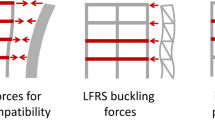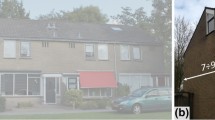Abstract
In the seismic retrofit of existing masonry constructions, global interventions are often needed to inhibit the onset of local mechanisms and to engage the whole building box-like structural behaviour. Such interventions are represented by perimeter ties and roof and floor diaphragms. This paper considers the roof diaphragm strengthening solution and investigates the use of stud connections securing the roof thin-folded shell to the perimeter walls. Stud connections serve the dual purpose of collecting and transferring the out-of-plane inertia forces of the masonry walls to the roof diaphragm, as well as transferring the diaphragm reaction forces to the shear walls. Specific detailing of the stud connection and the adoption of an improved lime-mortar overlay on the top of the masonry walls are proposed to improve the connection strength; without such improvements, the connection capacity would be jeopardised by the reduced shear resistance of the masonry wall due to the absence of significant vertical confining action at the roof level. The intervention entirely changes the behaviour of the connection and significantly reduces shear stresses on the masonry wall. The structural behaviour of the connection is analysed and discussed. Emphasis is made on the conceptual design of laboratory and in-field test procedures and testing frames in order to replicate the boundary conditions in real applications. In-situ tests may help during the design of the roof thin-folded shell system and allow for the efficiency assessment of the connections prior to the final intervention, thereby proving the actual feasibility of the retrofit solution.
















Similar content being viewed by others
References
ACI 530/530.1-13: Building code requirements and specification for masonry structures and companion commentaries
Ahmadi BH, Saka MP (1993) Behavior of composite timber-concrete floors. J Struct Eng 119(10):3111–3130
American Concrete Institute Committee 318 (ACI) (2008) Building code. Requirements for structural concrete (ACI 318-08) and commentary (ACI 318R-08), American Concrete Institute, Farmington Hills, Michigan
Auclair SC, Sorelli L, Salenikovich A (2016) Simplified nonlinear model for timber-concrete composite beams. Int J Mech Sci 117:30–42
Biolzi L, Giuriani E (1990) Bearing capacity of a bar under transversal loads. Mater Struct 23:449. https://doi.org/10.1007/bf02472028
Borri A, Corradi M, Castori G, De Maria A (2015) A method for the analysis and classification of historic masonry. Bull Earthq Eng. https://doi.org/10.1007/s10518-015-9731-4
Carbonara G (2003) Trattato di restauro architettonico. UTET, Torino
Cominelli S, Giuriani E, Marini A (2016) Mechanisms governing the compressive strength of unconfined and confined rubble stone masonry. Mater Struct. https://doi.org/10.1617/s11527-016-0905-6
D’Ayala D, Speranza E (2002) An integrated procedure for the assessment of seismic vulnerability of historic buildings [CD-ROM]. In: Proceedings of the 12th European conference on earthquake engineering, paper no. 561. Elsevier Science, London
D’Ayala D (2014) Conservation principles and performance based strengthening of heritage buildings in post-event reconstruction. Geotech Geol Earthq Eng 34:489–514
ETAG 029 (2010) Metal injection anchors for use in masonry
Eurocode 8 (2004) Design of structures for earthquake resistance. European Committee for Standardization (CEN). UNI EN 1998
Eurocode 5 (2005) Design of timber structures. European Committee for Standardization (CEN). UNI EN 1995:2005, Brussels
Felicetti R, Gattesco N, Giuriani E (1997) Local phenomena around a steel dowel embedded in a stone masonry wall. Mater Struct 30:238. https://doi.org/10.1007/BF02486182
Ferrario L, Marini A, Riva P, Giuriani E (2009) Traditional and innovative techniques for the seismic strengthening of barrel vaulted structures subjected to rocking of the abutments. In: ATC-SEI conference on improving the seismic performance of existing buildings and other structures, San Francisco, California, December 9–11, 2009
Gattesco N, Del Piccolo M (1997) Shear transfer between concrete members and stone masonry walls through driven dowels. Eur Earthq Eng 3:3–17
Gattesco N, Giuriani E (1996) Experimental study on stud shear connectors subjected to cyclic loading. J Constr Steel Res 38(1):1–21
Gelfi P, Giuriani E, Marini A (2002) Stud shear connection design for composite concrete slab and wood beams. ASCE J Struct Eng 128(12):1544–1550
Giuriani E (2011) Consolidamento degli edifici storici. Trattato di restauro architettonico. Ed. UTET, Torino. ISBN 978-88-598-0763-6
Giuriani E, Grisanti A (1986) Behaviour of stud connectors under repeated loads. Studi e Ricerche Corso di Perfezionamento delle Costruzioni in C.A. F.lli Pesenti. Politecnico di Milano 8:271–305
Giuriani E, Marini A (2008a) Experiences from the Northern Italy 2004 earthquake: vulnerability assessment and strengthening of historic churches. Invited paper. In: VI international conference on structural analysis of historical constructions SAHC 2008, pp 13–24. 2–4 July, Bath, England. Taylor and Francis, London, UK. ISBN 978-0-415-46872-5
Giuriani E, Marini A (2008b) Wooden roof box structure for the anti-seismic strengthening of historic buildings. J Archit Herit Conserv Anal Restor 2(3):226–246
Giuriani E, Gattesco N, Del Piccolo M (1993) Experimental tests on the shear behavior of dowels connecting concrete slabs to stone masonry walls. Mater Struct 26:293. https://doi.org/10.1007/BF02472951
Giuriani E, Marini A, Porteri C, Preti M (2009) Seismic vulnerability of churches associated to transverse arch rocking. Int J Archit Herit 3(1–24):2009
Giuriani E, Marini A, Preti M (2016) Thin-folded shell for the renewal of existing wooden roofs. J Archit Herit 10(6):797–816. https://doi.org/10.1080/15583058.2015.1075626
Griffith MC, Magenes G, Melis G, Picchi L (2003) Evaluation of out-of-plane stability of unreinforced masonry walls subjected to seismic excitation. J Earthq Eng 7(special issue 1):141–169
Hume I (1991) Conservation engineering—an English heritage view. In: Proceedings of STREMA (structural repair and maintenance of historical buildings), Seville, pp 3–12
Johnson RP (2008) Calibration of resistance of shear connectors in troughs of profiled sheeting. In: Proceedings of the Institution of Civil Engineers: Structures and Buildings, vol 161, no. 3
Johnson RP, Oehlers DJ (1996) Integrated static and fatigue design and assessment of stud shear connections in composite bridges. Struct Eng 74(14):236–240
Lagomarsino S, Podestà S, Risemini S, Curti E, Parodi S (2004) Mechanical models for the seismic vulnerability assessment of churches. In: Modena C, Lourenço PB, Roca P (eds) Structural analysis of historical construction. Proceedings of the IV international seminar SAHC, Padova, Italy, vol 2. A.A. Balkema, London, pp 1091–1101
Mainstone RJ, Menzies JB (1967) Shear Connectors in Steel-Concrete Composite Beams for Bridges; Part 1, Static and Fatigue Tests on Push-out Specimens. Concrete 1(9):291–302
Marini A, Giuriani E (2006) Transformation of wooden roof pitches into antiseismic shear resistance diaphragms. In: V international conference on structural analysis of historical constructions, pp 445–452. November 6–8, MacMillan India Ltd (Ind), New Delhi. ISBN 10:1403-93156-9
Marini A, Giuriani E, Lugoboni M, Cominelli S, Belleri A (2016) Le connessioni tra le coperture scatolari sismiche e le pareti perimetrali degli edifici storici. Technical Report 3/2016, Department of Civil Engineering, Architecture, Land, Environment and Mathematics of the University of Brescia (in Italian)
Marini A, Cominelli S, Zanotti C, Giuriani E (2018) Improved natural hydraulic lime mortar slab for compatible retrofit of wooden floors in historical buildings. Constr Build Mater 158:801–813. https://doi.org/10.1016/j.conbuildmat.2017.10.010
Menzies JB (1971) CP117 and shear connectors in steel-concrete composite beams made with normal-density or lightweight concrete. Struct Eng 49(3):137–154
Modena C, Casarin F, Da Porto F, Garbin E, Mazzon N, Munari M, Panizza M, Valluzzi MR (2009) Structural interventions on historical masonry buildings: review of eurocode 8 provisions in the light of the Italian experience. In: Cosenza E (ed) Proceedings of eurocode 8 perspectives from the Italian standpoint workshop. Doppiavoce, Napoli, pp 225–236
Oehlers DJ, Johnson RP (1987) The strength of stud shear connections in composite beams. Struct Eng 65B(2):44–48
Pallarés L, Hajjar JH (2010) Headed steel stud anchors in composite structures, part I: shear. J Constr Steel Res 66(2):198–212
Piazza M, Turrini G (1983) Il recupero statico dei solai in legno. Recuperare 7:396–407
Preti M, Loda S, Bolis V, Cominelli S, Marini A, Giuriani E (2017) Dissipative roof diaphragm for the seismic retrofit of listed masonry churches. J Earthq Eng. https://doi.org/10.1080/13632469.2017.136022
Ronca P, Gelfi P, Giuriani E (1991) The behaviour of a wood-concrete composite beam under cyclic and long term loads. In: Proceedings of the structural repair and maintenance of historical buildings II: 2nd international conference. Stremah 91, Brebbia, C. A., Seville, Spain, vol 1, pp 263–275
Shim CS (2004) Experiments on limit state design of large stud shear connectors. KSCE J Civ Eng 8:313. https://doi.org/10.1007/bf02836013
Stark JWB, van Hove BWEM (1991) Statistical analysis of push tests on stud connectors in composite steel and concrete structures. Report BI-91-163, TNO, Delft, September 1991
Tomăzevič M (1989) Some aspects of structural strengthening of historic buildings in urban and rural nuclei against earthquakes. Eur Earthq Eng 1(1989):19–40
Turnšek V, Terčelj S, Sheppard P, Tomaževič M (1978) The seismic resistance of masonry walls and buildings. In: Proceedings of 6th European conference on earthquake engineering, Dubrovnik, vol 3, pp 255–262
Xue W, Ding M, Wang H, Luo Z (2008) Static behavior and theoretical model of stud shear connectors. J Bridge Eng 13(6):623–634
Zandonini R, Bursi OS (2002) Cyclic behavior of headed shear stud connectors. Composite construction in steel and concrete IV. ASCE, Reston, pp 470–482
Acknowledgements
Financial support for this research project was provided by Reluis 2010–2012-Pr1-Strutture in Muratura. The authors gratefully acknowledge engineers Mauro Lugoboni and Carlo Tengattini for their valuable contribution in carrying out the experimental laboratory tests on specimens A–C, and B, respectively.
Author information
Authors and Affiliations
Corresponding author
Appendix: Laboratory test results on stud connections in Specimen A and C
Appendix: Laboratory test results on stud connections in Specimen A and C
Laboratory test results on stud connections in Specimen A and C are summarised in Table 1 in terms of (Fig. 17):
-
Yield Load and net yield displacement (Vy, sy), excluding the initial recovery of possible clearances;
-
Nominal Shear Capacity V10 defined as the shear load at 10 mm net of relative slip;
-
Maximum applied load Vmax;
-
Net Initial Stiffness K defined as the initial slope of the curve in which initial inelastic slip induced by stud-hole clearance recovery is removed. Note that it may substantially differ from the Gross Cyclic Stiffness, defined as the slope of the line connecting two subsequent load reversal points, which reduces due to incremental damage caused by the repeated sliding. The net initial stiffness corresponds to V1 defined as the shear load at a net relative slip of 1 mm, excluding the initial recovery of clearances anytime V1 < Vmax;
Rights and permissions
About this article
Cite this article
Marini, A., Giuriani, E., Belleri, A. et al. Dowel connections securing roof-diaphragms to perimeter walls in historic masonry buildings and in-field testing for capacity assessment. Bull Earthquake Eng 16, 4001–4025 (2018). https://doi.org/10.1007/s10518-018-0333-9
Received:
Accepted:
Published:
Issue Date:
DOI: https://doi.org/10.1007/s10518-018-0333-9





